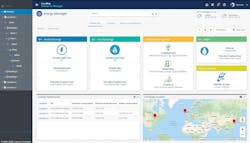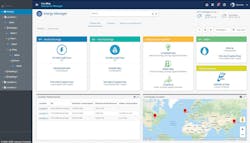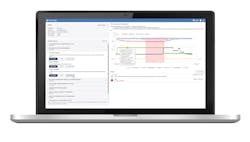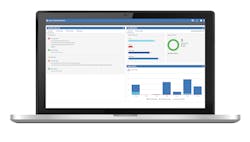How BAS Systems Can Help Create Healthier, Future-Proof Buildings
By VINEET SINHA and ROBERT HARLAND, Johnson Controls
Building automation systems (BAS) have evolved over the past decade, from basic operational automation systems with limited functionality to modern platforms that deliver rich features and deep analytics.
New automation systems can now help organizations meet their overall business goals including inspiring healthy people, creating productive work environments, and meeting large-scale sustainability targets, such as decarbonization and net-zero emissions. Even with the high level of automation available, building owners and operators encounter some common challenges that stand in the way of reaching those kinds of goals.
A recent customer poll conducted by Johnson Controls found these challenges include:
- Staff skills and productivity;
- Limited troubleshooting capabilities;
- Lack of commitment to cybersecurity;
- Static design and inability to adapt;
- Failing to modernize aging system components.
Cutting-edge building management systems (BMS), with their robust building automation and enterprise management technologies, can address these challenges.
In a collaborative setting, building automation technology is operating the facility on a full-time basis while an enterprise management system is handling the data analysis and artificial intelligence (AI) for critical insights. These technologies are able to unify through smart edge devices that can ingest and tag system assets, process data, and suggest impactful actions to the operator.
Here are some specific ways building management technologies have evolved to help building owners and operators overcome each of those common challenges.
STAFF SKILLS AND PRODUCTIVITY
With smaller teams handling more space, today’s facility operators are under enormous time pressure. To alleviate that stress and optimize productivity, BAS platforms are being designed with the end user in mind. BAS manufacturers are offering intuitive operating systems that require minimal training because they are organized according to clearly defined space and equipment relationships, allowing an end user to navigate the BAS quickly without complete knowledge of the BAS architecture.
Highly intuitive BAS platforms take design inspiration from consumer applications, so the interface works in a way that is familiar and friendly to the operator. With this intuitive design, operators can begin using the system almost as soon as it is installed.
In particular, enterprise management tools can help support staff productivity in three key areas:
- Maintenance: The maintenance team works in a closed loop and is very connected to work orders. A BMS can predict, detect and report maintenance needs and even plan a schedule to improve efficiency and time usage. This team can also complete prescriptive actions, often remotely, to cover when skilled tradespeople are unavailable;
- Energy and sustainability: This team is enriched by the system’s effort to monitor building operations and prescribe actions to enhance savings and bolster sustainability efforts. Effective monitoring is achieved by utilizing the spaces and equipment relationships to discern the interactive relationship of the connected devices and equipment within a facility. This makes it easier for a building owner to know which building systems operations can be refined to impact business goals;
- Workplace real estate: For the team responsible for occupancy issues, an enterprise management system can assist in space usage, monitoring indoor air quality, improving the living and work environment, and planning for the future use of building spaces. A thoroughly developed system database and 3D facility visualization are critical for these functions, as they greatly help planning for both immediate and future needs.
The recent impact of COVID-19 on workplace occupancy provides a good example to the benefits of enterprise management technologies for staff efficiency. When critical workers return to their facilities, they are spread over their normal footprint across the building or campus. Even though actual capacity is minimal, it is likely that the entire facility is being operated assuming full occupancy, which translates to wasted energy.
With enterprise management productivity and efficiency protocols, the efficiency of both staff members and energy usage can be closely monitored, managed and optimized for profit and success.
TROUBLESHOOTING CAPABILITIES
As a time-consuming daily activity, equipment troubleshooting is a priority for modern BAS platforms to address. BAS manufacturers have started integrating tools into their platforms that help streamline the process for operators. These include:
- Fault detection: Monitors and analyzes operation to detect and predict issues of concern. The issues are ranked according to their level of severity, which are then presented to the end user for next steps. This enables the much-desired evolution from scheduled to condition-based maintenance;
- Fault triage: Uses case-based learning to suggest possible solutions for users to research. Users provide feedback into what worked and what didn't work, allowing the system to improve its future recommendations;
- Fault monetization: Quantifies the monetary impact of each fault. It assists in both prioritization and building the business case to address faults.
BAS-supported troubleshooting leverages these tools to examine rolling data and determine where deviations are occurring outside the efficiency threshold, then responds accordingly. This includes minor, singular deviations, as well as larger issues that may accrue over a long period of time.
Autonomous fault correction tools are emerging that leverage data science to build AI models that help minimize impact on business continuity by detecting performance deviations, data anomalies and inefficient operational logic, and apply corrections without human intervention. Building operators can review these corrections to ensure that any human-made adjustments are fed back into the AI for maximum efficiency and effectiveness.
RENEWED FOCUS ON CYBERSECURITY
All too often an afterthought, cybersecurity is extremely critical to the health and future-proofing of a building and a business. And as many building operators can attest, activities to support cybersecurity are an ongoing journey. Intelligent operators understand that a building’s cybersecurity plan must continuously evolve as technology and tactics advance.
Knowing where to begin is often a challenge. The best BAS will offer cybersecurity dashboards that organize vulnerability data and make it understandable. With that data, operators can make informed decisions about their cybersecurity weaknesses. When a risk is uncovered, the dashboard points out the best options, such as upgrading their system due to out-of-date software or performing maintenance due to an account-based issue.
A good building automation partner will take a holistic view of their customer’s cybersecurity needs. They will monitor building assets, ensure the right software versions are installed, check that all cybersecurity layers are enabled, and guide operators through the other benefits that come with centralized device and system management.
Even more robust cybersecurity features are possible through enterprise management systems via smart edge gateway technology. This can include built-in security layers to defend against general cyberattacks, to prevent unauthorized logins, and to protect exposed ports. Monitoring the health of the system is a key built-in feature, and such smart gateways also support remote installation of cybersecurity patches that protect systems from newly evolving threats.
OVERCOMING STATIC DESIGN, INABILITY TO ADAPT
An easy, common building management mistake is the over-specification of a controls system based on initial use only. That initial use will represent a fragment of actual ongoing building conditions such as space usage, occupancy, equipment age and external conditions. When fluctuations in those conditions occur over time, an over-specified controls system may not react accordingly, causing inefficiencies.
Traditional BAS was designed to support controls systems by automating the execution of control logic, but the increasing complexity of interconnected sensors and systems have made it harder for buildings to operate more efficiently. With thousands of data points being collected from discrete systems every day, modern BAS solutions need to support common data models that interpret data and identify trends while being agnostic to equipment OEM.
Standard BAS features such as data trending, alarms and space views are no longer enough to help buildings meet occupant needs and business goals. Modern BAS platforms have started integrating easy-to-use features that continuously monitor and adapt to building conditions to maximize the comfort, security and performance of buildings and occupants, while also contributing to energy and cost savings.
MODERNIZING AGING SYSTEM COMPONENTS
As operators prepare buildings for the next 10 or more years of business, it is crucial for their systems to be maintained at the most current software version capable. This is critical for both daily operations and for ongoing cybersecurity. The challenge is that many buildings and their systems have been in operation for many decades and are unable to gather certain data points and trends, often leading to necessary retrofit conversions.
BAS evolution has allowed for the emergence of solutions to address equipment modernization concerns. For example, the Johnson Controls Metasys BAS allows for technicians to conduct system-wide performance verification scans of existing installations to validate that the connected devices and equipment are operating per the site’s parameters, confirm that all hardware and software is at a current supported revision, and to pinpoint any potential security concerns. All data is provided to an owner as a detailed report listing out performance and modernization recommendations allowing an owner to make more informed decisions regarding their BAS. This type of reporting serves as an enhanced, smart version of a “check engine” light for numerous building systems.
To assist with system analysis, data from all these systems and automated operations can then be factored into a building performance index. This rating system enables benchmarking of current BMS performance, peer comparisons with other buildings in the portfolio and set goals for improvement, including modernization targets.
DELIVERING THE FUTURE
As building automation and enterprise management platforms continue to evolve, it is important for owners and operators to stay on top of these trends. To meet specific business and sustainability goals, they must turn to the latest technology to achieve the greatest possible efficiencies. By meeting these challenges, operators can have confidence that their building assets are contributing to healthy, future-proof facilities.
About the authors
Based in Milwaukee, Sinha is director and product general manager for Johnson Controls' OpenBlue connected enterprise solutions. Based in Nashville, Harland is Johsnon Controls' Metasys brand manager, Building Automation Systems & Controls.



